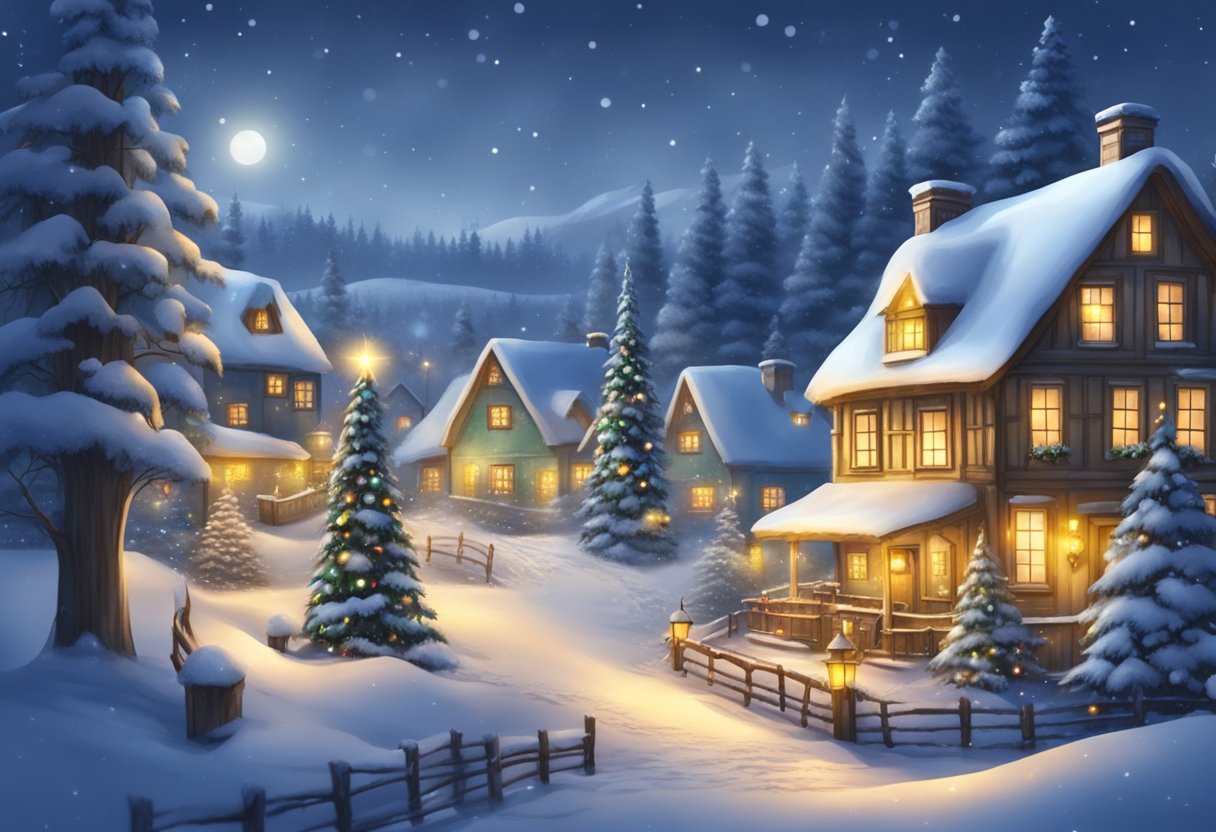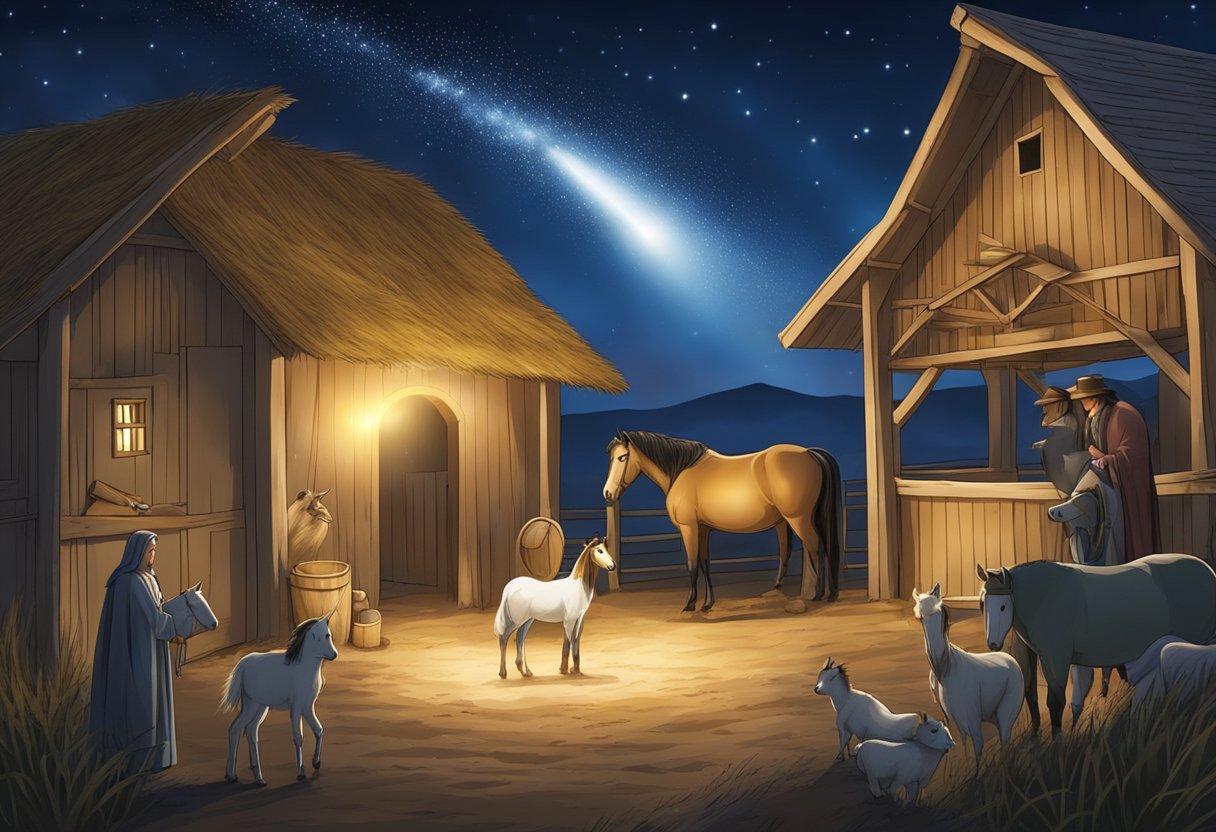Christmas
Christmas: Essential Traditions and Celebrations Explained
Christmas is a widely celebrated Christian festival commemorating the birth of Jesus Christ. Observed primarily on December 25, it has become a global phenomenon that transcends religious boundaries, uniting billions of people across various cultures in a spirit of joy, love, and giving. As an integral part of the Christian liturgical year, this holiday season is preceded by Advent or the Nativity Fast and initiates a period of reflection and celebration.  Beyond its religious significance, Christmas has evolved into a secular family holiday observed by both Christians and non-Christians. In recent times, the event has become increasingly known for the exchange of gifts, festive feasts, and the mythical figure of Santa Claus. Most importantly, Christmas signifies a time for families and communities to come together, strengthening bonds and creating lasting memories. The origin of Christmas can be traced back to ancient times, with varying customs and traditions woven into its rich history. It encompasses a blend of pagan and Christian practices that vary across different regions and societies. These diverse traditions, such as decorations, carols, and holiday food, have culminated in the modern Christmas experience, celebrated worldwide with joy and anticipation.
Beyond its religious significance, Christmas has evolved into a secular family holiday observed by both Christians and non-Christians. In recent times, the event has become increasingly known for the exchange of gifts, festive feasts, and the mythical figure of Santa Claus. Most importantly, Christmas signifies a time for families and communities to come together, strengthening bonds and creating lasting memories. The origin of Christmas can be traced back to ancient times, with varying customs and traditions woven into its rich history. It encompasses a blend of pagan and Christian practices that vary across different regions and societies. These diverse traditions, such as decorations, carols, and holiday food, have culminated in the modern Christmas experience, celebrated worldwide with joy and anticipation.
Origins of Christmas
The origins of Christmas can be traced back to both Christian and pre-Christian traditions. Christmas is a Christian festival celebrating the birth of Jesus Christ. The term “Christmas” derived from the Old English “Cristes-messe,” meaning “Christ’s mass,” which is of fairly recent origin. The earlier term “Yule” may have come from the Germanic jōl or the Anglo-Saxon geōl, referring to the feast of the winter solstice. The selection of December 25th as the date to celebrate Jesus’ birth has both religious and historical significance. Some scholars attribute this choice to the early Christian theologian Sextus Julius Africanus, who believed that Christ was conceived on March 25th and born nine months later on December 25th. Others suggest that the date was chosen to coincide with existing pagan festivals like the Roman Saturnalia, which celebrated the winter solstice, or the birth of the Persian god Mithra, who was associated with the sun. Some of the customs now associated with Christmas have pre-Christian origins, such as the Yule log, which was originally a pagan tradition celebrating the winter solstice. Over time, these customs were incorporated into Christian celebrations as the religion spread through the Roman Empire. The first Christmas feast held on December 25th took place in Rome in 336 A.D., after Christianity had become the Empire’s official religion. This date was later adopted in the Gregorian calendar, while some Eastern Orthodox churches still use the Julian calendar to celebrate Christmas on January 6th, also known as Old Christmas. The nativity story, which is central to the Christian celebration of Christmas, tells of the miraculous birth of Jesus to the Virgin Mary and her husband Joseph. As many different cultures and regions adopted Christianity, the celebration of Christmas also began to incorporate local customs, leading to diverse traditions around the world. Although the origins of Christmas are rooted in religious traditions, the holiday has evolved over time to include secular symbols and customs. Many popular festivities, such as decorating Christmas trees and exchanging gifts, have developed independently of the commemoration of Jesus’ birth. These practices reflect a blend of cultural influences and the shared human experience of celebrating longer days and the return of light during the dark winter months.
Christian Significance
 The Christian significance of Christmas revolves around the celebration of the birth of Jesus Christ, the central figure in Christianity. This religious holiday commemorates the miracle of Jesus’ birth and the fulfillment of Old Testament prophecies. As a Christian festival, the primary focus is on the spiritual aspects of Jesus’ life and teachings, making it a time for reflection, gratitude, and renewal of faith. Christmas is typically observed by attending special church services, where believers gather to worship and honor the birth of Jesus. Many Christian denominations, such as the Catholic Church and Protestant churches, celebrate Christmas on December 25th. The season preceding Christmas is known as Advent, marked by the use of Advent calendars and Advent wreaths to represent the anticipation and preparation leading up to Jesus’ birth. In addition to the religious practices, many Christian families display nativity scenes in their homes, depicting the biblical story of Jesus’ birth in Bethlehem. These scenes usually feature figures representing baby Jesus, Mary, Joseph, the shepherds, and the three wise men who followed the star to bring gifts to the newborn King. The Epiphany, celebrated on January 6th, marks the conclusion of the Christmas season for some Christians and commemorates the visitation of the Magi to the baby Jesus. Churches emphasize the importance of Christmas as a time to reflect on the life and teachings of Jesus Christ, focusing on themes such as love, peace, and hope. Particular attention is given to the belief in Jesus’ divine status, as both fully human and fully divine. Alongside the birth of Jesus, Christians also celebrate His resurrection and conception as crucial moments in their faith.
The Christian significance of Christmas revolves around the celebration of the birth of Jesus Christ, the central figure in Christianity. This religious holiday commemorates the miracle of Jesus’ birth and the fulfillment of Old Testament prophecies. As a Christian festival, the primary focus is on the spiritual aspects of Jesus’ life and teachings, making it a time for reflection, gratitude, and renewal of faith. Christmas is typically observed by attending special church services, where believers gather to worship and honor the birth of Jesus. Many Christian denominations, such as the Catholic Church and Protestant churches, celebrate Christmas on December 25th. The season preceding Christmas is known as Advent, marked by the use of Advent calendars and Advent wreaths to represent the anticipation and preparation leading up to Jesus’ birth. In addition to the religious practices, many Christian families display nativity scenes in their homes, depicting the biblical story of Jesus’ birth in Bethlehem. These scenes usually feature figures representing baby Jesus, Mary, Joseph, the shepherds, and the three wise men who followed the star to bring gifts to the newborn King. The Epiphany, celebrated on January 6th, marks the conclusion of the Christmas season for some Christians and commemorates the visitation of the Magi to the baby Jesus. Churches emphasize the importance of Christmas as a time to reflect on the life and teachings of Jesus Christ, focusing on themes such as love, peace, and hope. Particular attention is given to the belief in Jesus’ divine status, as both fully human and fully divine. Alongside the birth of Jesus, Christians also celebrate His resurrection and conception as crucial moments in their faith.
Christmas Customs and Traditions
 Christmas is a widely celebrated holiday, with various customs and traditions observed around the world. In many countries, the festivities begin on Christmas Eve and continue until Christmas Day. One common element of these celebrations is the display and decoration of Christmas trees. These trees, usually evergreens, are adorned with Christmas lights, ornaments, and tinsel. During the holiday season, it is customary for people to send Christmas cards to their friends and loved ones. These cards often feature festive images, seasonal greetings, and sometimes even a brief update on the sender’s life during the past year. A central part of Christmas celebrations is the sharing of a special Christmas dinner with family or friends. While the menu may vary depending on the region, popular dishes include roasted meats, side dishes with seasonal vegetables, and festive desserts such as Christmas pudding or fruitcake. People often indulge in their favorite Christmas songs during this time, creating a lively and joyful atmosphere. Gift-giving is another essential tradition of Christmas. The exchange of gifts is practiced among families (Christmas gift for Mom, Christmas gift ideas for Him) friends, and communities, with many people attributing this custom to the story of the Magi or Wise Men who presented gifts to the baby Jesus. In some cultures, gifts are believed to be delivered by a mythical figure, such as Santa Claus, Father Christmas, or St. Nicholas, who is said to travel with a team of reindeer and visit the homes of well-behaved children. Many people also incorporate various symbols of the season into their decorations. For instance, holly, mistletoe, and wreaths are commonly used to adorn homes and public spaces, while a yule log may be burned in the fireplace as a symbol of warmth and light during the darkest time of the year. The nativity scene, which depicts the birth of Jesus and the visit of the shepherds and Magi, is an important element of Christian celebrations. This scene is often displayed in homes, churches, and public areas, reminding people of the biblical story behind the holiday. In many cultures, Christmas is a time of feasting and light, with candles and other illuminations brightening homes and public spaces alike. From festive decorations inside and outside of homes to the joyful gatherings of family and friends, the Christmas season brings warmth, joy, and a spirit of togetherness for people around the world.
Christmas is a widely celebrated holiday, with various customs and traditions observed around the world. In many countries, the festivities begin on Christmas Eve and continue until Christmas Day. One common element of these celebrations is the display and decoration of Christmas trees. These trees, usually evergreens, are adorned with Christmas lights, ornaments, and tinsel. During the holiday season, it is customary for people to send Christmas cards to their friends and loved ones. These cards often feature festive images, seasonal greetings, and sometimes even a brief update on the sender’s life during the past year. A central part of Christmas celebrations is the sharing of a special Christmas dinner with family or friends. While the menu may vary depending on the region, popular dishes include roasted meats, side dishes with seasonal vegetables, and festive desserts such as Christmas pudding or fruitcake. People often indulge in their favorite Christmas songs during this time, creating a lively and joyful atmosphere. Gift-giving is another essential tradition of Christmas. The exchange of gifts is practiced among families (Christmas gift for Mom, Christmas gift ideas for Him) friends, and communities, with many people attributing this custom to the story of the Magi or Wise Men who presented gifts to the baby Jesus. In some cultures, gifts are believed to be delivered by a mythical figure, such as Santa Claus, Father Christmas, or St. Nicholas, who is said to travel with a team of reindeer and visit the homes of well-behaved children. Many people also incorporate various symbols of the season into their decorations. For instance, holly, mistletoe, and wreaths are commonly used to adorn homes and public spaces, while a yule log may be burned in the fireplace as a symbol of warmth and light during the darkest time of the year. The nativity scene, which depicts the birth of Jesus and the visit of the shepherds and Magi, is an important element of Christian celebrations. This scene is often displayed in homes, churches, and public areas, reminding people of the biblical story behind the holiday. In many cultures, Christmas is a time of feasting and light, with candles and other illuminations brightening homes and public spaces alike. From festive decorations inside and outside of homes to the joyful gatherings of family and friends, the Christmas season brings warmth, joy, and a spirit of togetherness for people around the world.
Christmas Around the World
https://www.youtube.com/watch?v=DdAeYRh83nI&embed=true Christmas is a cultural holiday celebrated in different ways across the globe. Its origins stem from Christian traditions, but the way it is observed can vary greatly between countries and cultures. In this section, we’ll explore how Christmas is celebrated in some areas such as the United States, Canada, Mexico, United Kingdom, Germany, Scandinavia, Austria, and Japan. In the United States and Canada, Christmas is a public holiday typically celebrated with gift-giving, festive decorations, and family gatherings. Christmas trees, stockings, and Santa Claus are all staple symbols of the holiday. Traditional dishes, such as turkey or ham, mashed potatoes, and cranberry sauce often grace the dinner table. Mexico brings its unique flair to the Christmas celebrations, with an event called Las Posadas. Taking place over nine days leading up to Christmas, this reenactment commemorates Mary and Joseph’s search for shelter before Jesus’ birth. Families carry candles and sing carols as they visit homes, ultimately culminating in a festive gathering with food, piñatas, and celebrations. In the United Kingdom, Christmas Day is also a public holiday centered around family gatherings, festive meals, and gift-giving. Christmas pudding, a dense, fruity dessert, is a popular highlight of the British holiday feast. Carol singing and Christmas crackers, containing small toys, paper hats, and jokes, are other endearing aspects of the UK’s Christmas celebrations. Germany has a rich history of Christmas traditions, including the famous Christmas markets that take place in towns and cities across the country. These markets offer an array of holiday treats, handmade crafts, and seasonal decorations. Advent calendars and candlelit wreaths also play a significant role in the German holiday season. In Scandinavia, Christmas celebrations are steeped in ancient traditions related to the winter solstice and the Norse god Odin. Modern observances often include a blend of Christian customs and older pre-Christian traditions. A notable Scandinavian figure during the festive period is the Yule Goat, a creature from Nordic folklore symbolizing the spirit of giving. Austria shares some similarities with German Christmas traditions, particularly the Advent season and the holiday markets. One unique Austrian custom is the appearance of Krampus, a horned, demonic figure who serves as a counterpart to St. Nicholas and frightens children into good behavior. Traditional Austrian treats, such as cookies and seasonal cakes, are enjoyed during the holiday celebrations. Lastly, in Japan, where Christmas is not a public holiday, the holiday has taken on a unique form. Although Japan does not have a significant Christian population, it has adopted some Christmas traditions in a more secular and commercial manner. One interesting custom is the widespread consumption of KFC fried chicken as a Christmas meal, which is a result of a highly successful marketing campaign in the 1970s that has continued to endure. As seen through these examples, Christmas celebrations vary widely around the world, reflecting diverse cultural influences, personal beliefs, and local customs.
Controversies and Criticisms
Throughout the history of Christmas, there have been numerous controversies and criticisms that have arisen from various perspectives. Some of the most significant disagreements revolve around the origins, practices, and commercialization of the holiday. A significant point of contention can be traced back to the early Christian church’s decision to recognize December 25th as the birthday of Jesus. The exact origins of this choice have been debated, with some scholars pointing to the Roman festival of Saturnalia and the birth of the sun god Sol Invictus. Emperor Constantine’s adoption of Christianity in the 4th century led to the amalgamation of pagan and Christian traditions for Christmas celebrations. This blending of elements has been a source of controversy, particularly amongst specific religious groups. The Puritans, for instance, fervently opposed what they considered a corruption of religious practices. In the 17th century, they even banned the observance of Christmas in England and parts of America due to its connections with pagan festivities. This opposition extended to specific holiday customs such as decorating trees, which can also be linked to pre-Christian winter celebrations. The use of evergreen trees as a symbol of life and renewal predates Christianity and has caused disputes over whether it should have a place in religious celebrations. Another area of critique involves the increasing commercialization of Christmas, with some individuals feeling that the original meaning of the holiday has been overshadowed by consumerism. Advertising campaigns and early store displays have come under fire for capitalizing on the holiday spirit and encouraging excessive spending. This aspect of Christmas has led to disapproval from multiple segments of society, who argue that the emphasis should be on community, spirituality, and reflection rather than material pursuits. In conclusion, controversies surrounding Christmas have persisted for centuries and stem from various aspects of the holiday’s history, practices, and commercialization. Each debate touches on differing interpretations of what the celebration should signify and whether certain traditions are appropriate or detract from the original intent.